8 Hawks in Wisconsin
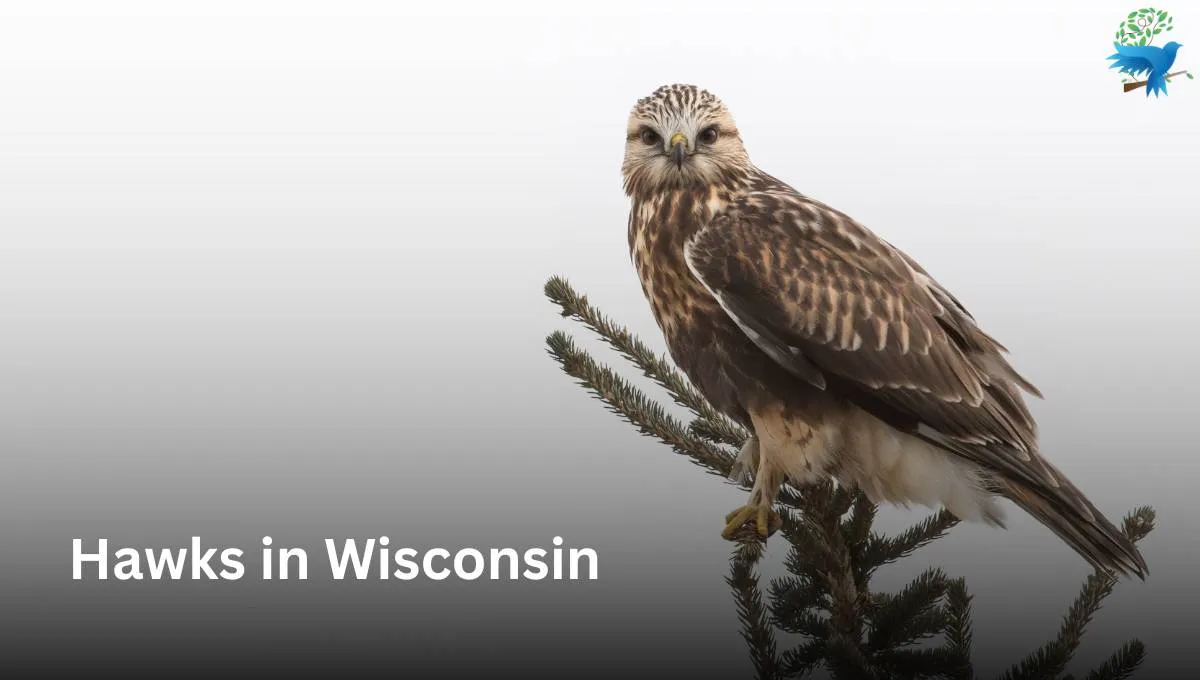
Wisconsin, commonly referred to as America’s Dairyland, is not only known for its cheese production and attractive scenery, but it also has a broad range of wildlife, including a large number of hawks.
Wisconsin, in the heart of the Midwest, provides various habitats for hawks, including woods, wetlands, grasslands, and open fields.
These majestic birds of prey are essential in preserving ecological balance and are renowned for their excellent hunting abilities and aerial acrobatics.
So, let’s move forward and learn more about the Hawks in Wisconsin in detail.
List 8 of Hawks in Wisconsin
- Red-tailed Hawk (Buteo Jamaicensis)
- Red-shouldered Hawk (Buteo Lineatus)
- Sharp-shinned Hawk (Accipiter Striatus)
- Cooper’s Hawk (Accipiter Cooperii)
- Broad-winged Hawk (Buteo Platypterus)
- Rough-legged Hawk (Buteo Lagopus)
- Swainson’s Hawk (Buteo Swainsoni)
- Northern Harrier (Circus hudsonius)
1. Red-tailed Hawk (Buteo Jamaicensis)
The red-tailed hawk, also known as the Buteo genus, is widespread worldwide in North America and other regions.
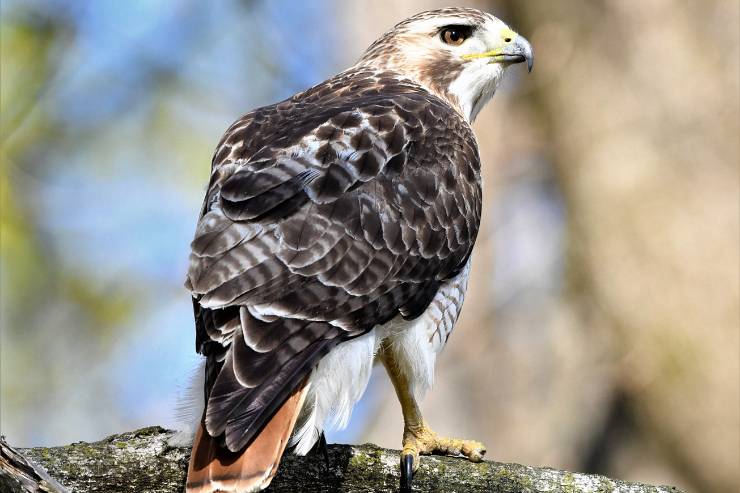
These species can be identified by their rich brown upperparts and lighter underparts, complemented by striped bellies and a conspicuous dark band on the underside of their wings. Their tails are generally pale below and cinnamon-red above.
Red-tailed hawks have an average lifespan of about 12 years in the wild, but they can live up to 30 years in captivity.
- Size:- 45-56 centimeters (17.7-22.1 inches)
- Wingspan: 114-133 centimeters (44.9-52.4 inches)
- Weight: 690-1300 grams (24.3-45.9 oz)
- Lifespan: 12 (years in the wild), 30 years (in captivity)
- Conservation status: Widespread and common
Habitat: The red-tailed hawk can adapt to various locations and elevations, including deserts, grasslands, coniferous and deciduous forests, agricultural landscapes, and even urban areas.
It usually prefers multiple environments, including open forests, woodland edges, and terrain.
Feeding: The main diet of red-tailed hawks consists primarily of squirrels, although they also hunt rodents, reptiles, rabbits, and various bird species.
Additionally, they are opportunistic feeders, sometimes stealing food from other raptors like eagles and owls.
2. Red-shouldered Hawk (Buteo Lineatus)
Red-shouldered hawks, also known as Buteo Lineatus, are medium-sized hawks. They have dark-and-white speckled wings and apparent warm reddish stripes across their breasts.
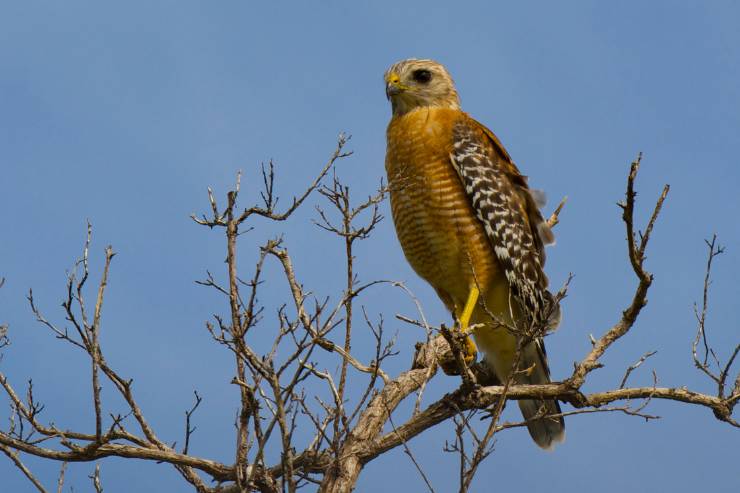
Their tails are black with thin white bands. In the wild, these hawks can live for up to five years.
- Size: 43-61 centimeters (16.9-24.0 inches)
- Wingspan: 94-111 centimeters (37.0-43.7 inches)
- Weight: 486-774 grams (17.1-27.3 oz)
- Lifespan: 5 years (in wild)
- Conservation status: Least Concern
Habitat: Red-shouldered hawks prefer mature mixed forests with a mix of deciduous and coniferous trees.
They favor wet wooded habitats, especially those in low-lying places near rivers, marshes, swamps, and streams.
Feeding: Red-shouldered Hawks primarily eat small animals, reptiles such as lizards, snakes, and amphibians. They sometimes also consume crawfish and other bird species.
3. Sharp-shinned Hawk (Accipiter Striatus)
The sharp-shinned hawk, often known as a sharpie, is a small species known as the little hawk.
Adult Sharp-shinned Hawks have blue-gray upperparts, white underparts, and white necks. They are distinguished by their small stature, lengthy tails, and short, rounded wings.
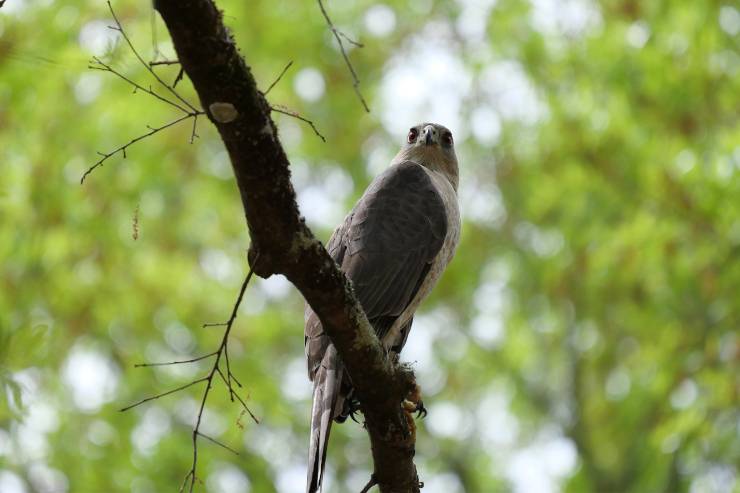
- Size: 24-34 centimeters(9.4-14.4 inches)
- Wingspan: 43-56 centimeters (16.9-22.1 inches)
- Weight: 87-218 grams(3.1-7.7 oz)
- Lifespan: Three years
- Conservation status: Low Concern (Population is growing)
Habitat: Sharp-shinned hawks are rarely seen breeding in Indiana, but they are more visible during spring and fall migrations and throughout the winter season.
They prefer the cover of dense woodlands.
Feeding: The Sharp-shinned Hawk’s primary food consists of tiny birds, ranging from sparrows to robins, while it may occasionally hunt on larger species such as quails. It also eats rats, squirrels, bats, lizards, snakes, and frogs.
4. Cooper’s Hawk (Accipiter Cooperii)
Cooper’s hawks are medium-sized hawks with moderate-length wings, a long tail that is often curved or wedge-shaped, and long but robust legs and toes.
They have an elevated stance. Their upperparts are bluish-gray, with a distinctive black crown and scarlet eye. Cooper’s Hawks have a lifespan of about twelve years and are rapidly increasing in number.

- Size: 37-39 centimeters (14.6-15.3 inches)
- Wingspan: 62-90 centimeters (24.4-35.4)
- Weight: 220-410 grams (7.8-14.5 oz)
- Lifespan: 12 years
- Conservation status: Low concern
Habitat: Cooper’s Hawks can be found in various wooded and semi-wooded habitats throughout southern Canada, most of the United States, and specific areas of Mexico. They like areas with taller trees.
Feeding: Cooper’s Hawks primarily rely on a diet of birds and small mammals. Their preferred prey includes medium-sized birds like jays, flickers, and robins.
5. Broad-winged Hawk (Buteo Platypterus)
The broad-winged Hawk, a medium-sized member of the Buteo genus, has reddish-brown heads, barred underparts, and striking black and white stripes on its tail.
According to research conducted between 1955 and 1979, wild broad-winged hawks live for an average of 12 years.
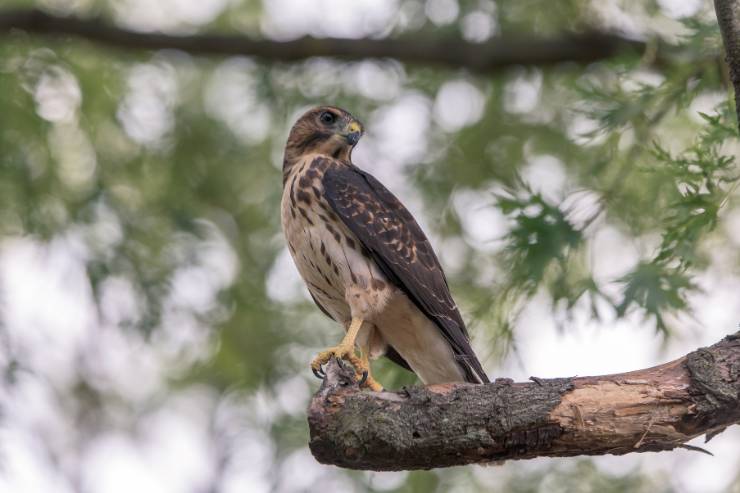
A wild broad-winged hawk’s most extended reported lifespan is at least 14 years and four months.
- Size: 33-44 centimeters (13.4-17.3 inches)
- Wingspan: 81-100 centimeters (31.9-39.4 inches)
- Weight: 265-560 grams (9.3-19.8 oz)
- Lifespan: 12 years
- Conservation status: Least Concern
Habitat: The winged Hawk lives in dense, continuous, and mixed forests, including deciduous and coniferous trees.
Feeding: Broad-winged Hawks eat various foods, including small mammals, amphibians, reptiles, and birds. They also eat rodents like mice and voles and smaller mammals like squirrels.
6. Rough-legged Hawk (Buteo Lagopus)
The rough-legged hawk, also referred to as the rough-legged falcon and scientifically classified as Buteo lagopus, is a large hawk distinguished by its broad wings, which are relatively long and narrow compared to other hawks of the Buteo genus.
The usual lifespan of a rough-legged hawk is approximately two years. Rough-legged hawk populations are generally stable and considered to be of little concern.
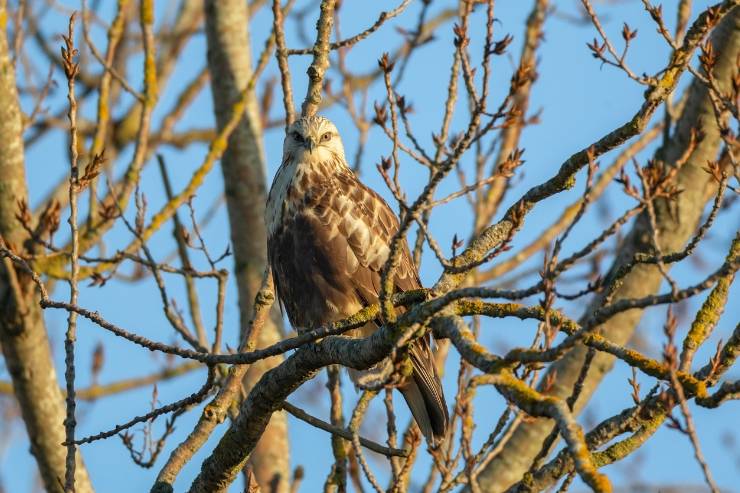
- Size: 47-52 centimeters (18.5-20.5 inches)
- Wingspan: 132-138 centimeters (52.0-54.3 inches)
- Weight: 715-1400 grams (25.2-49.4 oz)
- Lifespan: Two years
- Conservation status: Least Concern
Habitat: Rough-legged hawks are common in the Arctic and Subarctic regions of Russia, Europe, and North America during the breeding season; however, they fly south in the winter and live in open spaces like farms, fields, marshes, and grasslands throughout the winter.
Feeding: Rough-legged Hawks feed mostly on tiny rodents such as voles and lemmings. Although they occasionally seek larger food like Arctic Ground Squirrels and rabbits, their primary winter diet consists of small mammals like mice and shrews.
7. Swainson’s Hawk (Buteo Swainsoni)
The Swainson’s hawk is a massive bird species in the Accipitriformes group. The British naturalist William Swainson inspired its naming.
Informally, it is known as the grasshopper hawk or locust hawk. It is identified by a vast, pointed-tipped hawk with extended wings.
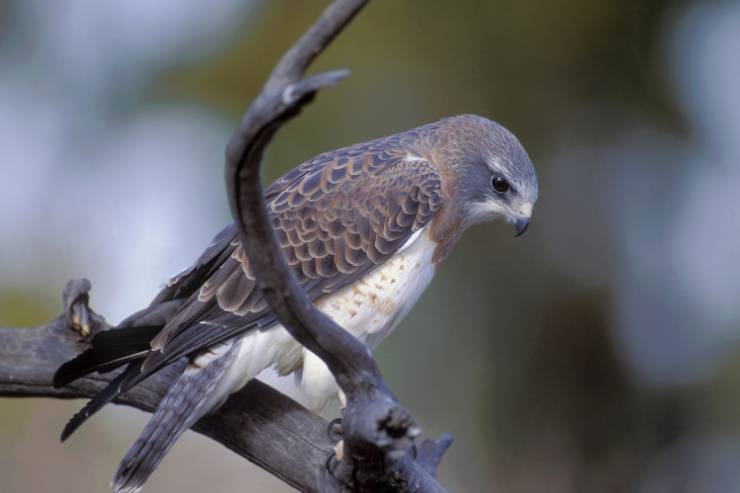
Its wings are usually slightly elevated when it soars. Adults have a broad, black trailing edge to the wing due to their dark flying feathers. Its life span is up to fifteen years.
- Size: 46-56 centimeters (18-22 inches)
- Wingspan: 119-150 centimeters (47-59 inches)
- Weight: 650-1100 grams (22.92-38.80 oz)
- Lifespan: up to 15 years
- Conservation status: Least concern
Habitat: Swainson’s Hawks live in savannas, grasslands, steppes, and farmed areas.
Feeding: In the early summer, these species primarily consume small animals and reptiles; in other seasons, they eat giant insects.
8. Northern Harrier (Circus Hudsonius)
Northern Harriers, also known as ring-tailed or marsh hawks and scientifically classified as Circus hudsonius, are easily identifiable from afar.
They are slender, long-tailed hawks frequently seen soaring low over marshes or grasslands. Their wings form a unique V-shape with a white patch at the tail base.
Northern harriers’ most extended reported lifespan is 16 years and five months, with an average lifespan of approximately 16.6 months.
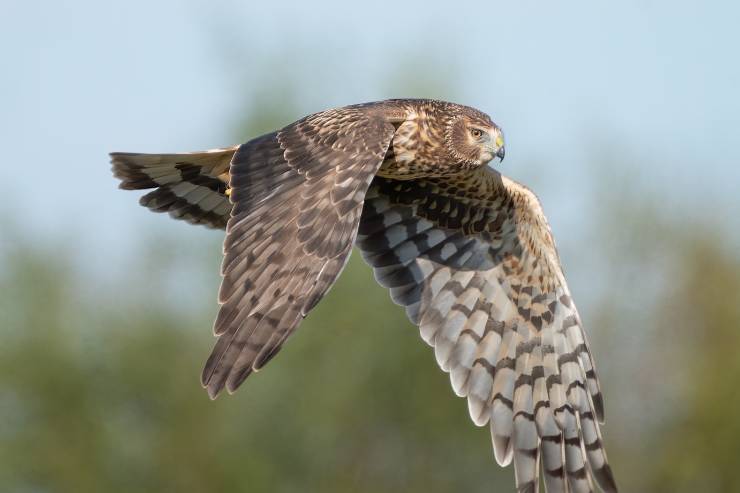
- Size: 46-50 centimeters (18.1-19.7 inches)
- Wingspan: 102-118 centimeters (40.2-46.5 inches)
- Weight: 300-750 grams (10.6-26.5 oz)
- Lifespan: 16 years and 6 months
- Conservation status: Least concern (but population decreasing)
Habitat: They can be seen all year in several parts of the United States, including the Midwest, Mountain West, and North Atlantic states.
The Northern Harrier prefers open areas like marshes and grasslands across its range. They usually build their nests on the ground, either alone or in scattered groups.
Feeding: During the summer, harriers mostly eat small to medium-sized mammals, with a fondness for rodents, birds, amphibians, and insects.
Their winter diet is mainly composed of animals and birds, yet each harrier has different tastes in food based on where they are.
Conclusion
In conclusion, several kinds of hawk species may be found in Wisconsin thanks to its different habitats, and each one helps maintain the ecological balance of the state.
Conservation initiatives are essential to guarantee the health of hawk populations in the future. We can save these amazing birds for future generations through habitat preservation, education, and ethical wildlife management.
In addition to adding to Wisconsin’s natural beauty, hawks also symbolize the health and vitality of ecosystems.
By working together, we can protect their habitats and make sure that these fantastic animals will always be able to fly over Wisconsin.
Frequently Asked Question
Does Wisconsin protect hawks?
Indeed, the Migratory Bird Treaty Act protects hawks and forbids harming, harassing, or possessing them without the necessary permissions.
What food do hawks consume?
As predatory birds, hawks mostly eat small animals such as squirrels, voles, mice, and rabbits. They also consume insects, birds, and reptiles.
What is the most common hawk species found in Wisconsin?
The Red-tailed Hawk (Buteo jamaicensis) is the most prevalent species of hawk in Wisconsin. It is common throughout the state and can be found in urban areas, meadows, and woodlands.






